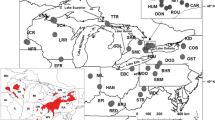Abstract
Lingcod, Ophiodon elongatus Girard, have a 3-month pelagic larval stage and are an important recreational and commercial species on the west coast of North America. Cytochrome-c oxidase I sequences from tissue samples were used to characterize population structure and infer patterns of gene flow from California to Alaska. No significant genetic structure was found when estimates of Wright’s FST (i.e., ΦST) were generated among all populations sampled. Nesting populations within regions, however, indicated that the inner coast of Washington State is distinct, a result corroborating previous allozyme work. Coalescent-based estimates of gene flow indicate that although migration can be high from an evolutionary perspective, nearly half of all comparisons among populations showed no gene flow in at least one direction. From an ecological perspective, moderate migration rates (Nm < 10) among most populations provide surprisingly limited connectivity at large (∼ 1,000 km) and small (∼100 km) spatial scales. Coalescent-based estimates also show that gene flow between the inner and the outer coasts is asymmetric, a result consistent with prevailing surface currents. Because the expected inter-locus variances for coalescent-based estimates of gene flow are likely large, future work will benefit from analyses of nuclear DNA markers. However, limited demographic connectivity on large spatial scales may help explain why stock recovery has been uneven, with greater recovery in the northern (87% rebuilt) than in the southern (24% rebuilt) fishery region, supporting a regional management strategy. These results suggest that despite a 3-month pelagic larval stage, some areas may be effectively closed with respect to both population dynamics and fishery management issues.





Similar content being viewed by others
References
Abdo Z, Crandall K A, Joyce P (2004) Evaluating the performance of likelihood methods for detecting population structure and migration. Mol Ecol 13:837–851
Avise JC (2004) Molecular markers, natural history, and evolution, 2nd edn. Sinauer, Sunderland
Beerli P (2004) Effect of unsampled populations on the estimation of population sizes and migration rates between sampled populations. Mol Ecol 13:827–836
Beerli P, Felsenstein J (1999) Maximum-likelihood estimation of migration rates and effective population numbers in two populations using a coalescent approach. Genetics 152:763–773
Beerli P, Felsenstein J (2001) Maximum likelihood estimation of a migration matrix and effective population sizes in n subpopulations by using a coalescent approach. Proc Natl Acad Sci USA 98:4563–4568
Bohonak AJ (1999) Dispersal, gene flow, and population structure. Q Rev Biol 74:21–45
Bohonak AJ (2002) IBD (isolation by distance): a program for analyses of isolation by distance. J Hered 93:153–154
Botsford LW, Micheli F, Hastings A (2003) Principles for the design of marine reserves. Ecol Appl 13:S25–S31
Burton RS (1982) Protein polymorphisms and genetic differentiation of marine invertebrate populations. Mar Biol Lett 4:193–206
Cass AJ, Beamish RJ, McFarlane GA (1990) Lingcod (Ophiodon elongatus). Can Spec Publ Fish Aquat Sci 109:40
Clement M, Posada D, Crandall K (2000) TCS: a computer program to estimate gene genealogies. Mol Ecol 9:1657–1660
Collin PL (2003) Larvae retention: genes or oceanography? Science 300:1657–1658
Cowen RK, Lwiza KMM, Sponaugle S, Paris CB, Olson DB (2003) Connectivity of marine populations: open or closed? Science 287:857–859
Crowder LB, Lyman SJ, Figueira WF, Priddy J 2000 Source–sink population dynamics and the problem of siting marine reserves. Bull Mar Sci 66:799–820
Dethier MN, McDonald K, Strathmann RR (2003) Colonization and connectivity of habitat patches for coastal marine species distant from source populations. Conserv Biol 17:1024–1035
Donaldson KA, Wilson RR (1999) Amphi-panamic geminates of snook (Percoidei: Centropomidae) provide a calibration of the divergence rate in the mitochondrial DNA central region of fishes. Mol Phylogenet Evol 13:208–213
Ebbesmeyer CC et al (1984) Synthesis of current measurements in Puget Sound, Washington, vol 3. Circulation in Puget Sound: an interpretation based on historical records of currents. NOAA (National Oceanographic and Atmospheric Administration) Technical Memorandum NOS (National Ocean Service), OMS-5, Rockville
Excoffier L, Smouse PE, Quattro JM (1992) Analysis of molecular variance inferred from metric distances among DNA haplotypes—application to human mitochondrial DNA restriction data. Genetics 131:479–491
Fraser DJ, Bernatchez L (2001) Adaptive evolutionary conservation: towards a unified concept for defining conservation units. Mol Ecol 10:2741–2752
Grosberg RK (1991) Sperm-mediated gene flow and the genetic structure of a population of the colonial ascidian Botryllus schlosseri. Evolution 45:130–142
Gyllenstein U (1985) The genetic structure of fish: differences in the intraspecific distribution of biochemical variation between marine anadromous, and freshwater species. J Fish Biol 26:691–700
Hare MP, Weinberg JR (2005) Phylogeography of surfclams, Spisula solidissima, in the western North Atlantic based on mitochondrial and nuclear DNA sequences. Mar Biol 146:707–716
Hart JL (1973) Pacific fishes of Canada. Bull Fish Res Bd Can 180:740
Hickerson MJ, Ross JRP (2001) Post-glacial population history and genetic structure of the northern clingfish (Gobbiesox maeandricus), revealed from mtDNA analysis. Mar Biol 138:407–419
Hudson RR (1990) Gene genealogies and the coalescent process. Oxf Surv Evol Biol 7:1–44
Jagielo TH (1994) Assessment of lingcod (Ophiodon elongatus) in the area north of 45°46’ (Cape Falcon) and south og 49°00′ N in 1994. Appendix I, In: Status of the Pacific groundfish fishery through 1994 and recommended biological catches for 1995: stock assesment and fishery evaluation, Pacific Fishery Management Council, Portland
Jagielo TH (1995) Abundance and survival of lingcod at Cape Flattery, Washington. Trans Am Fish Soc 124:170–183
Jagielo TH (1999) Movement, mortality, and size selectivity of sport- and trawl-caught lingcod off Washington. Trans Am Fish Soc 128:31–48
Jagielo TH, Wallace FR (2005) Assessment of Lingcod, Ophiodon elongatus, for the Pacific Fishery Management Council in 2005, Report
Jagielo TH, LeClair LL, Vorderstrasse BA (1996) Genetic variation and population structure of lingcod. Trans Am Fish Soc 125:372–386
Jones GP, Milicich MJ, Emslie MJ, Lunow C (1999) Self-recruitment in a coral reef fish population. Nature 402:802–804
Kimura M (1980) A simple model for estimating evolutionary rates of base substitutions through comparative studies of nucleotide sequences. J Mol Evol 16:111–120
Kingman JFC (1982a) The coalescent. Stoch Process Appl 13:235–248
Kingman JFC (1982b) Essays in statistical science: on the genealogy of large populations. J Appl Prob 19A:27–43
Kinlan BP, Gaines SD (2003) Propagule dispersal in marine and terrestrial communities: a community perspective. Ecology 84:2007–2020
Kuhner MK, Yamato J, Felsenstein J (1998) Maximum likelihood estimation of population growth rates based on the coalescent. Genetics 149:429–434
Largier JL (2003) Considerations in estimating larval dispersal distances from oceanographic data. Ecol Appl 13:S71–S89
Marko PB (2002) Fossil calibration of molecular clocks and the divergence times of geminate species pairs separated by the Isthmus of Panama. Mol Biol Evol 19:2005–2021
Marko PB (2004) ‘What’s larvae got to do with it?’ Patterns of post-glacial population structure in two benthic marine gastropods with identical dispersal potential. Mol Ecol 13:597–611
Mora C, Sale PF (2002) Are populations of coral reef fishes open or closed? Trends Ecol Evol17:422–428
Moritz C (1994) Defining ‘Evolutionary Significant Units’ for conservation. Trends Ecol Evol 9:373–375
Nath H, Griffiths R (1993) The coalescent in two colonies with symmetric migration. J Math Biol 31:841–851
Neigel JE (2002) Is FST obsolete? Conserv Genet 3:167–173
Notohara M (1990) The coalescent and the genealogical process in geographically structured population. J Math Biol 29:59–75
O’Connell VM (1993) Submersible observations on lingcod, Ophiodon elongatus, nesting below 30 m off Sitka, Alaska. US Natl Mar Fish Serv Mar Fish Rev 55:19–24
Palumbi SR (1994) Genetic divergence, reproductive isolation, and marine speciation. Annu Rev Ecol Syst 25:547–572
Palumbi SR (2003) Population genetics, demographic connectivity, and the design of marine reserves. Ecol Appl 13:S146–S158
Palumbi SR, Martin AP, Romano SL, McMillan WOD, Stice L, Grabowski G (1991) The simple fool’s guide to PCR. Version 2.0. University of Hawaii, Honolulu
Phillips AC, Barraclough WE (1977) On the early life history of lingcod (Ophiodon elongatus). Can Fish Mar Serv Tech Rep 756, Nanaimo, 35 pp
Pluzhnikov A, Donnelly (1996) Optimal sequencing strategies for surveying molecular genetic diversity. Genetics 144:1247–1262
Pulliam HR (1988) Sources, sinks, and population regulation. Am Nat 132:652–661
Reed DC, Schroeter SC, Raimondi PT (2004) Spore supply and habitat availability as sources of recruitment limitation in the giant kelp Macrocystis pyrifera (Phaeophyceae). J Phycol 40:275–284
Riginos C, Nachman MW (2001) Population subdivision in marine environments: the contributions of isolation by distance, discontinuous habitat, and biogeography to genetic differentiation in a blennioid fish, Axoclinus nigricaudus. Mol Ecol 10:1439–1453
Roberts CM (1997) Connectivity and management of Caribbean coral reefs. Science 278:1454–1457
Rocha LA, Bass AL, Robertson DR, Bowen BW (2002) Adult habitat preferences, larval dispersal, and the comparative phylogeography of three Atlantic surgeonfishes (Teleostei: Acanthuridae). Mol Ecol 11:243–252
Rogers AR, Harpending HC (1993) Population growth makes waves in the distribution of pairwise genetic differences. Mol Biol Evol 9:552–569
Rogers-Bennett L, Bennett WA, Fastenau HC, Dewees CM (1995) Spatial variation in red sea urchin reproduction and morphology: implications for harvest refugia. Ecol Appl 5:1171–1180
Schneider S, Kueffer J, Roessli D, Excoffier L (1997) Arlequin version 1.1: a software for population genetic data snalysis. Genetics and Biometry Laboratory, University of Geneva, Switzerland
Seeb LK (1998) Gene flow and introgression among three species of rockfishes, Sebastes auriculatus, S. caurinus, and S. maliger. J Hered 89:393–403
Shulman MJ, Bermingham E (1995) Early life histories, ocean currents, and the population genetics of Caribbean reef fishes. Evolution 49:897–910
Sotka EE, Wares JP, Barth JA, Grosberg RK, Palumbi SR (2004) Strong genetic clines and geographical variation in gene flow in the rocky intertidal barnacle Balanus glandula. Mol Ecol 13:2143–2156
Starr RM, O’Connell V, Ralston S (2004) Movements of lingcod (Ophiodon elongatus) in southeast Alaska: potential for increased conservation amd yield fom marine reserves. Can J Fish Aquat Sci 61:1083–1094
Strub PT, James C (2000) Altimeter-derived variability of surface velocities in the California current system: 2. Seasonal circulation and eddy statistics. Deep-Sea Res Ii-Topical Stud Oceanograph 47:831–870
Swofford DL (2001) PAUP*. Phylogenetic analysis using parsimony (*and other methods), Version 4. Sinauer Associates, Sunderland
Swearer SE, Caselle JE, Lea DW, Warner RR (1999) Larval retention and recruitment in an island population of a coral-reef fish. Nature 402:799–802
Tarjuelo I, Posada D, Crandall KA (2004) Phylogeography and speciation of colour morphs in the colonial ascidian Pseudodistoma crucigaster. Mol Ecol 13:3125–3136
Taylor BL Dizon AE (1996) The need to estimate power to link genetics and demography for conservation. Conserv Biol 2:661–664
Taylor MS, Hellberg ME (2003) Genetic evidence for local retention of pelagic larvae in a Caribbean reef fish. Science 299:107–109
Templeton AR, Crandall KA, Sing CF (1992) A cladistic analysis of phenotypic associatations with haplotypes inferreed from restriction endonucelase mapping and DNA sequence data. III. Cladogram estimation. Genetics 132:619–633
Waples RS (1998) Separating the wheat from the chaff: patterns of genetic differentiation in high gene flow species. J Hered 89:438–450
Ward RD, Woodwark M, Skibinski DOF (1994) A comparison of genetic diversoty levels in marine freshwater, and anadromous fishes. J Fish Biol 44:213–232
Wares JP, Cunningham CW (2001) Phylogeography and historical ecology of the North Atlantic intertidal. Evolution 55:2455–2469
Whitlock MC, McCauley DE (1999) Indirect measures of gene flow and migration: FST ≠ 1/(4Nm + 1). Heredity 82:117–125
Acknowledgments
We thank the California Department of Fish and Game (CDFG), Eric Larson, and Patty Wolf for their support. Sport Fish Restoration Funds (Fund F-50-R-13 Project 18, Job 6.) from the CDFG, the University of North Carolina and the Friday Harbor Laboratories (University of Washington) helped fund this study. We thank port samplers in California, Washington and Alaska for tissue samples and Brian Allen and Brenda Erwin for coordinating the sampling in California. This is contribution Number 2312 Bodega Marine Laboratory, University of California, Davis and a contribution of Clemson University Public Service and Agriculture.
Author information
Authors and Affiliations
Corresponding author
Additional information
Communicated by J.P. Grassle, New Brunswick
Rights and permissions
About this article
Cite this article
Marko, P.B., Rogers-Bennett, L. & Dennis, A.B. MtDNA population structure and gene flow in lingcod (Ophiodon elongatus): limited connectivity despite long-lived pelagic larvae. Mar Biol 150, 1301–1311 (2007). https://doi.org/10.1007/s00227-006-0395-0
Received:
Accepted:
Published:
Issue Date:
DOI: https://doi.org/10.1007/s00227-006-0395-0




